We have our first proper shock of EURO 2020, as Switzerland defeated France on penalties in the round of 16 in Bucharest, after coming back from 3-1 down to level the scores in stoppage time of normal time. France were heavy favourites for the tournament, but were unable to make the most of the stunning array of talent at their disposal, and questions are already being raised of Didier Deschamps and his decision-making, especially with regard to this match. Switzerland now face Spain in the quarter-finals, and it would be foolish to write them off based on this display. In this tactical analysis piece, we will look at both sides’ tactics and try and explain how and why France were unable to keep Switzerland at bay.
Lineups
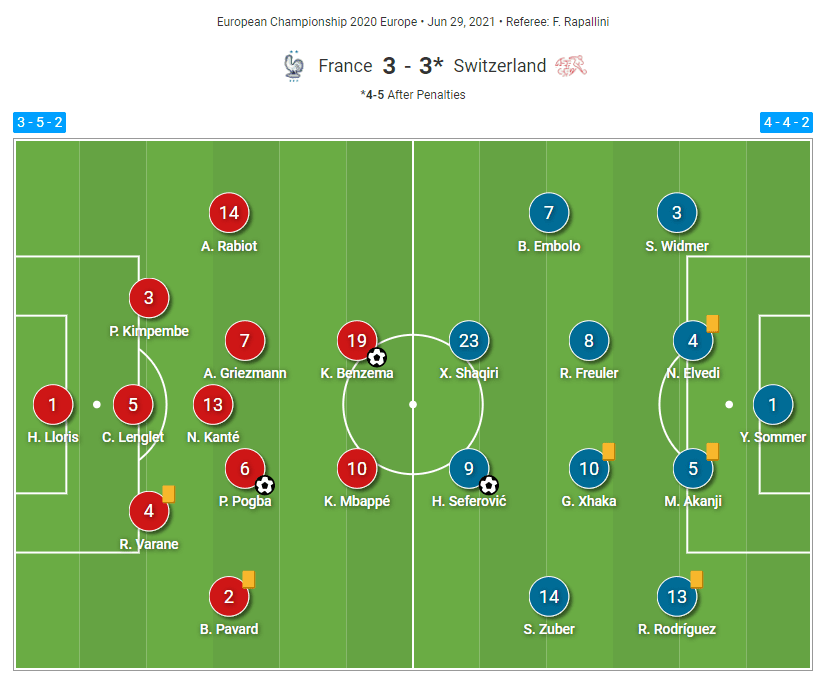
France were in the midst of an injury crisis at left-back, with both Lucas Hernandez and Lucas Digne unavailable, so Deschamps opted for a rather interesting solution by moving to a 3-4-1-2 shape (although Wyscout has them in a 3-5-2 here). Adrien Rabiot, the Juventus midfielder, was brought in to play at left wing-back, while Clément Lenglet came in as the third centre-back alongside Presnel Kimpembe and Raphaël Varane. The rest of the team was as expected.
Vladimir Petkovic played the same side as the one that had defeated Turkey in their last group game – they started the match in a 4-4-2 shape which changed to a 3-4-1-2 and back during the game.
France look awkward in a back three
While Deschamps had experimented with a back three in the pre-tournament friendlies, there was no denying that this was an unusual formation for France, and they looked quite uncomfortable in terms of their structure and play in this match. It was telling that Deschamps realized his mistake and switched to a 4-4-2 at half-time, also removing the hapless Lenglet, who was easily outjumped by Haris Seferović for Switzerland’s opener. France immediately looked far more threatening with Kingsley Coman instead on the pitch, but questions must be asked as to why Deschamps chose to start with the 3-4-1-2 in the first place.
Rabiot is a central midfielder by trade, and has rarely, if every, played as a wing-back or in any sort of wide position. Even when used as a wide midfielder for France earlier in EURO 2020, this was more as ‘false’ winger – he would usually tuck in centrally to become a third central midfielder alongside Paul Pogba and N’Golo Kanté rather than hugging the touchline. However, that was exactly what was expected of him in this role, and it is no surprise that he failed to provide any attacking thrust down the left, even with France attacking mostly down that flank in this match. The 26-year-old did stay wide, although he would occasionally rotate and allow the likes of Kylian Mbappé and Karim Benzema to go out to the left instead while coming infield. The issue was that he rarely tried to take on his direct opponent, usually Stefan Widmer, and attack the space behind the Swiss backline – instead, even when receiving the ball in 1v1 situations, he would pass the ball back to a French teammate. This meant that the majority of France’s play in the first half was in front of Switzerland’s defence, and they did not carry too much of a threat as a result.
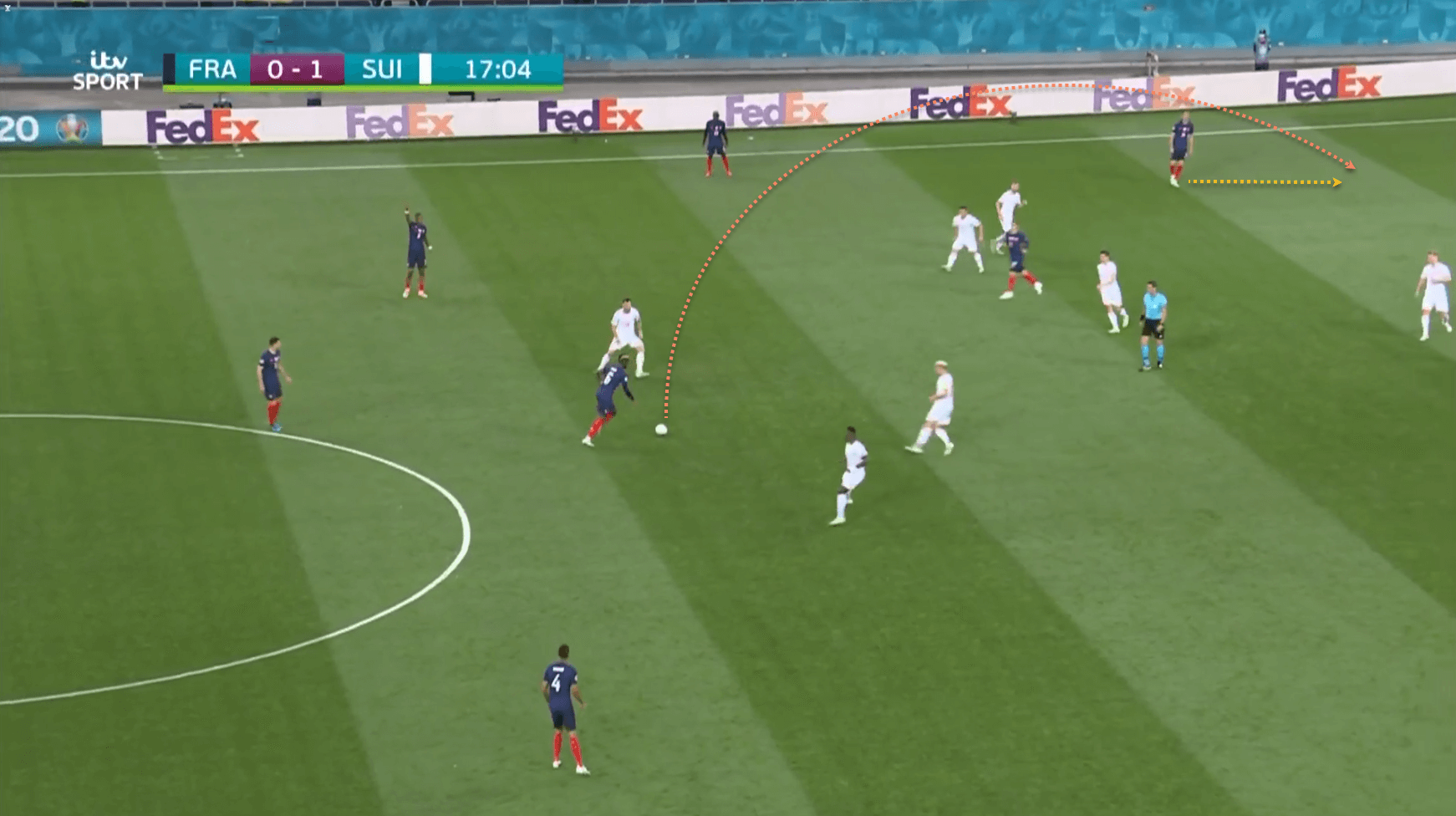
This is one such example – Pogba picks up the ball in midfield, and with no promising central options for ball progression, plays a good lofted ball out wide to Rabiot.
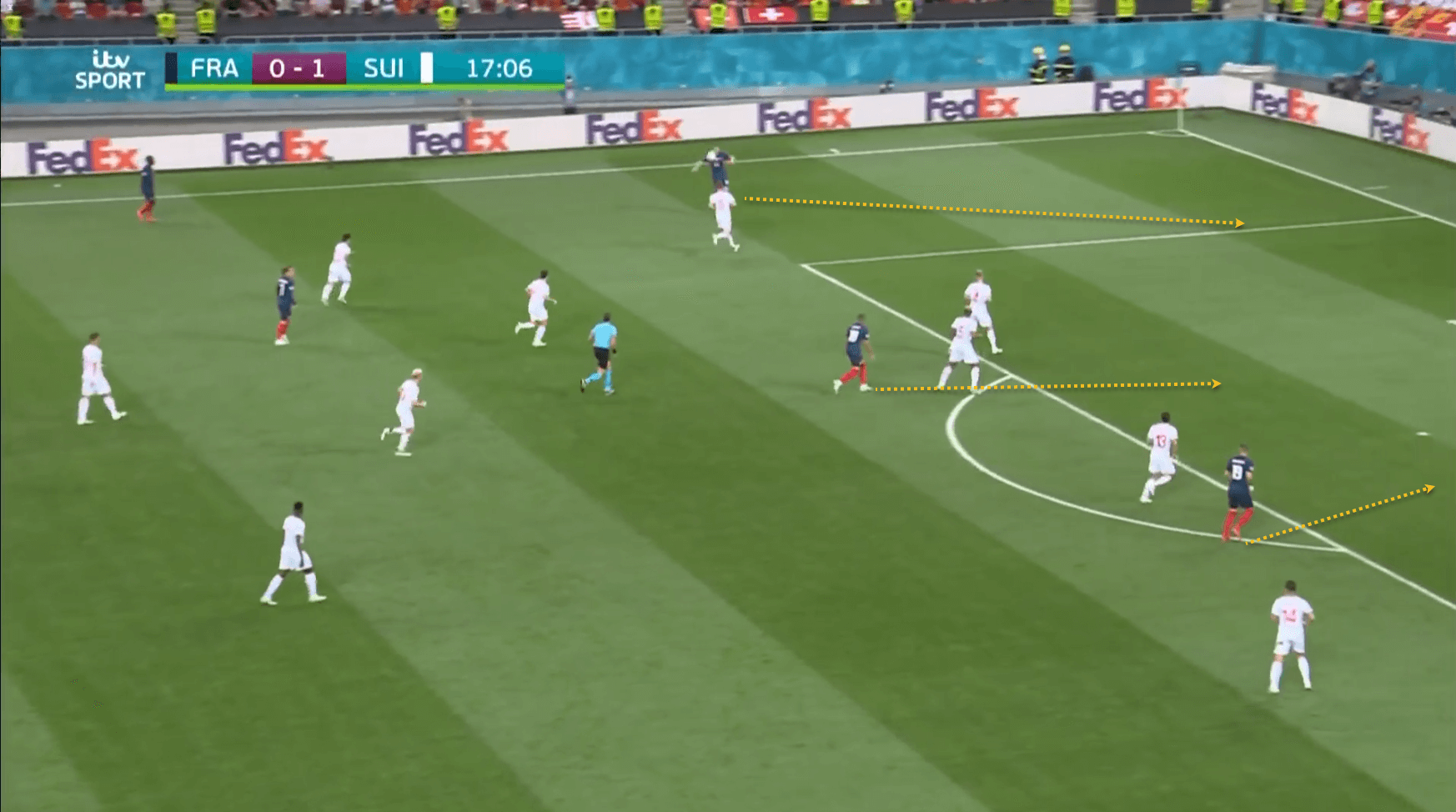
When Rabiot receives the ball, Mbappé and Benzema are both in position to make runs into the box, while Rabiot himself also has the space to drive forward if he can manage to get past Widmer.
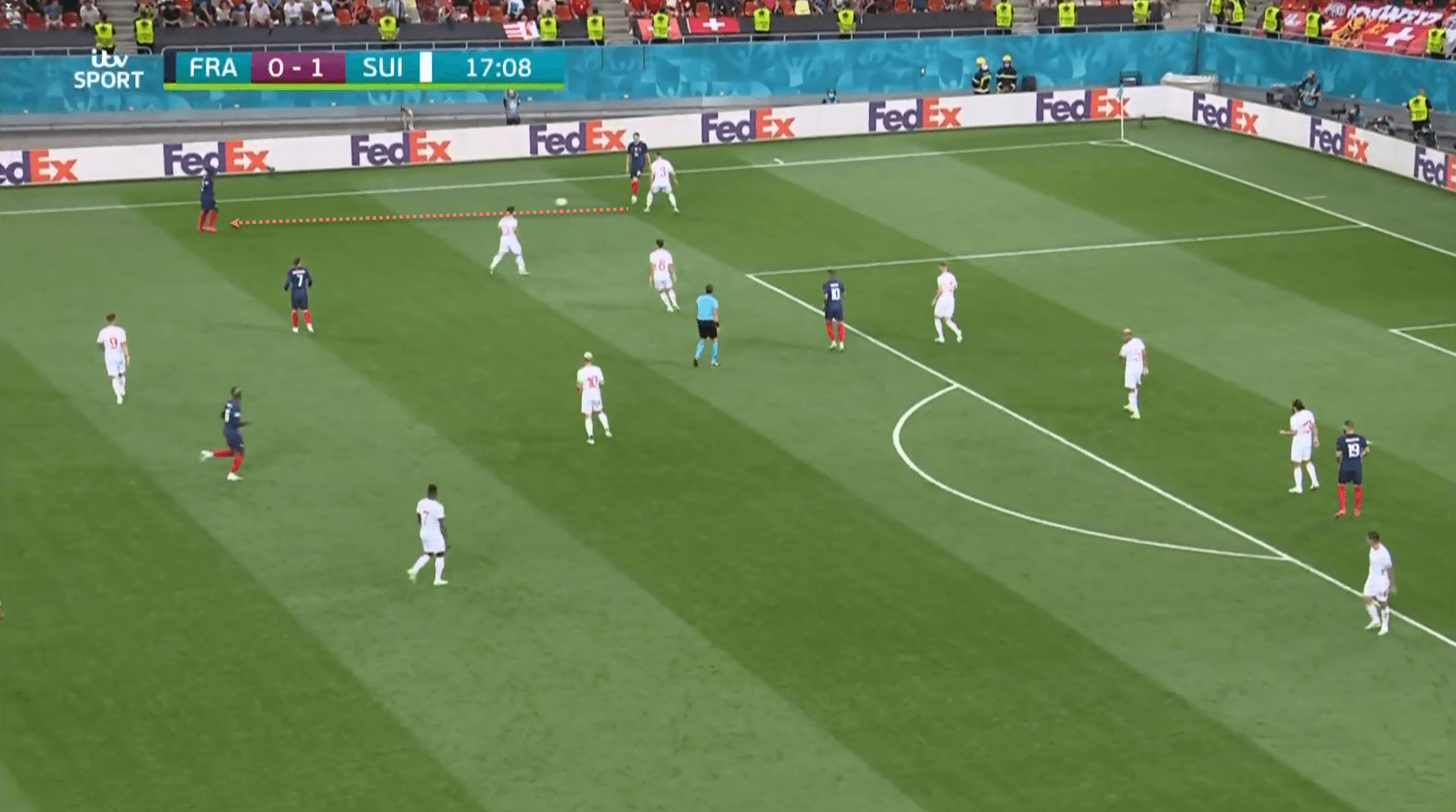
However, he plays the ball back to Kanté, and France are unable to penetrate.
Switzerland’s shape off the ball was excellent, denying France easy central passing options. Therefore, they needed to exploit the wide areas in a much better manner to drag the Swiss lines out of shape and create space for the likes of Antoine Griezmann, Pogba, Mbappé and Benzema. However, the use of this 3-4-1-2 meant that Switzerland could easily have the wing-backs jumping out to Rabiot and Benjamin Pavard on the opposite side, safe in the knowledge that there was no other wide attacking threat from France to defend against.
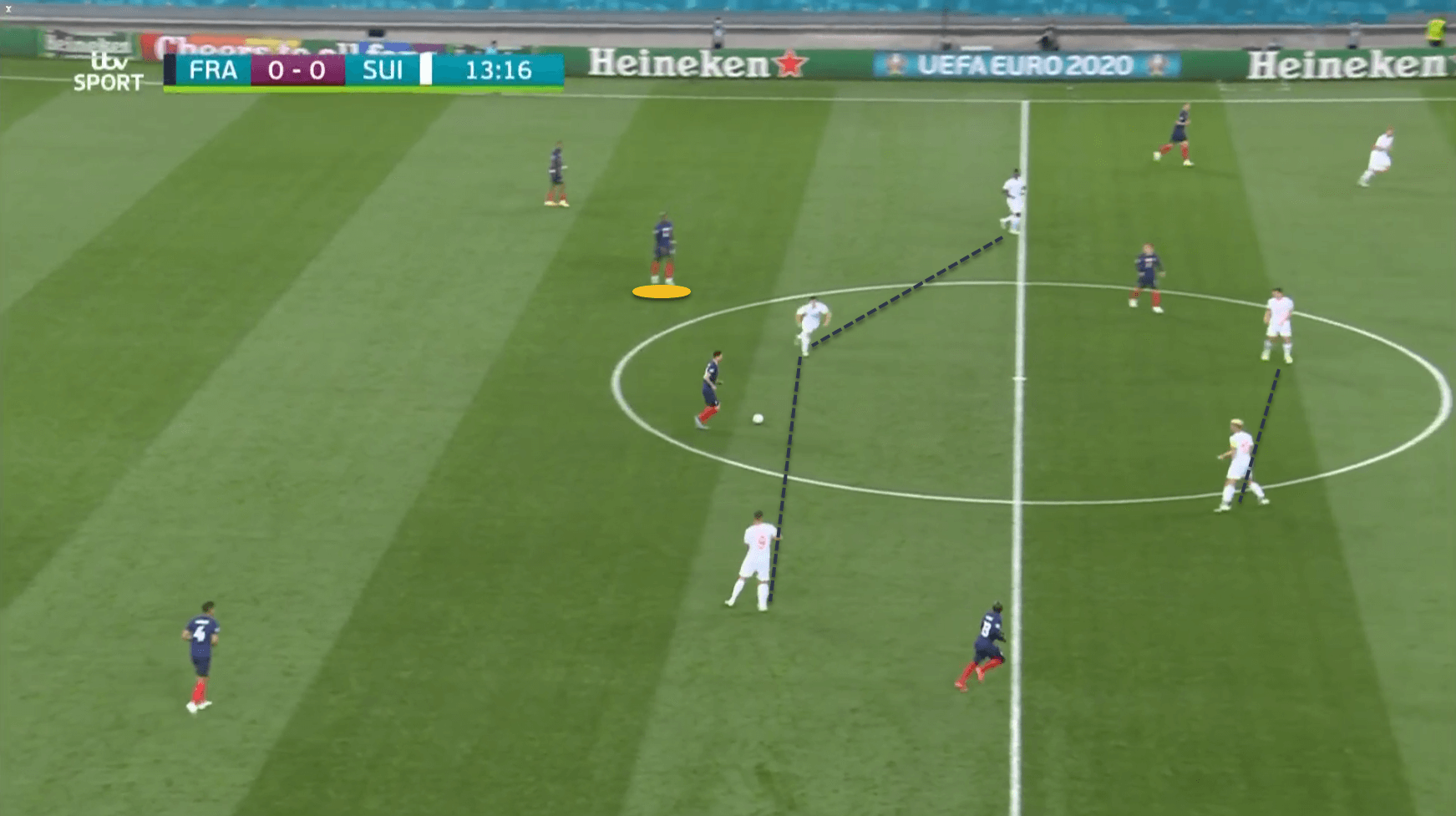
We can see an example of how well Switzerland clogged the central spaces and forced France back and wide. Pogba (circled) is forced to drop between his centre-backs here due to the lack of space to receive possession higher up the pitch, while we can also see how narrow the Swiss midfield and forward lines are here.
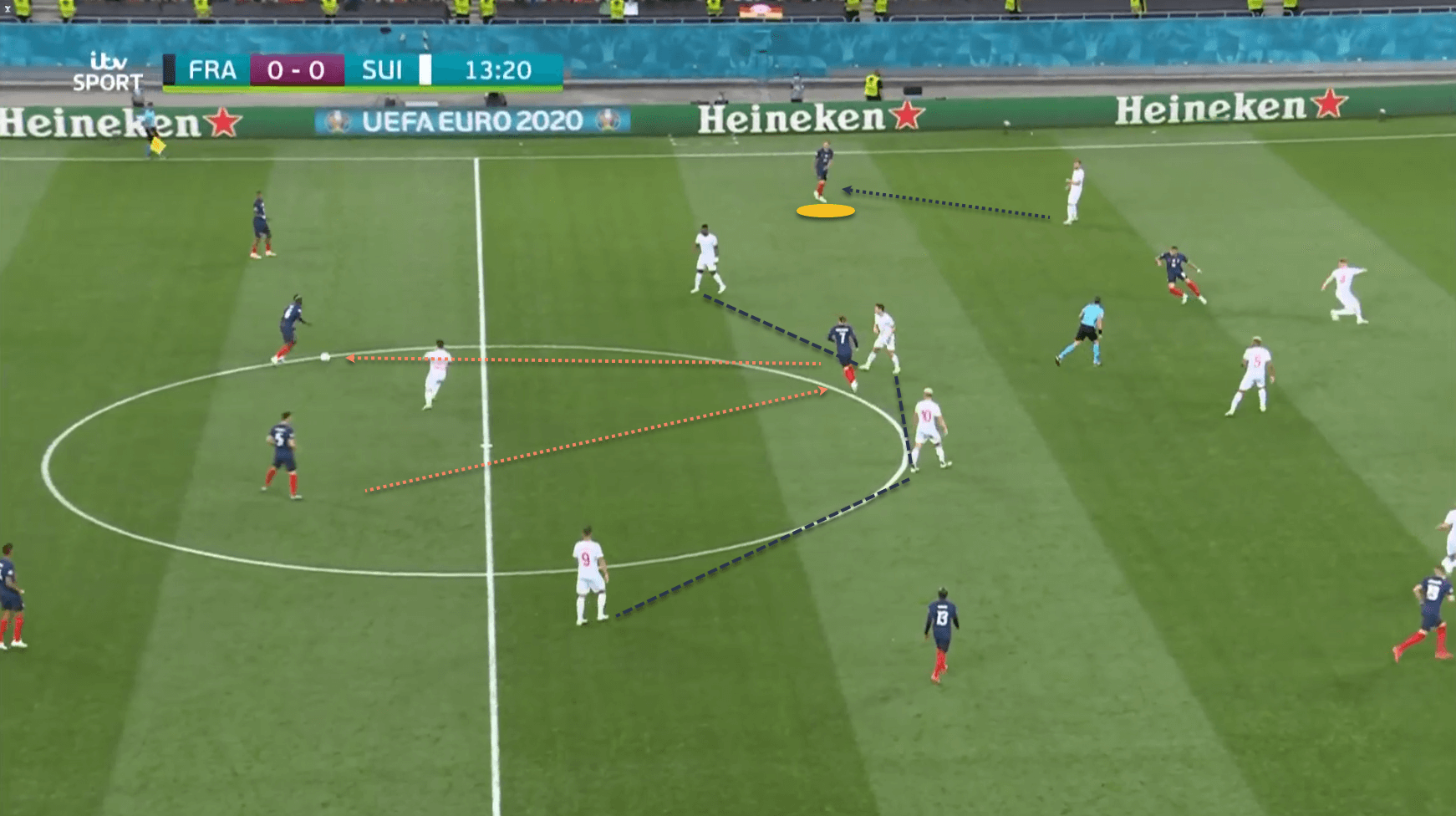
Lenglet advances and plays the ball to Griezmann, who is forced to pass back to Pogba due to the attention of Remo Freuler. Rabiot, on the left, is the only real passing option for Pogba here, with Widmer in close proximity to jump out to him the moment the pass is played.
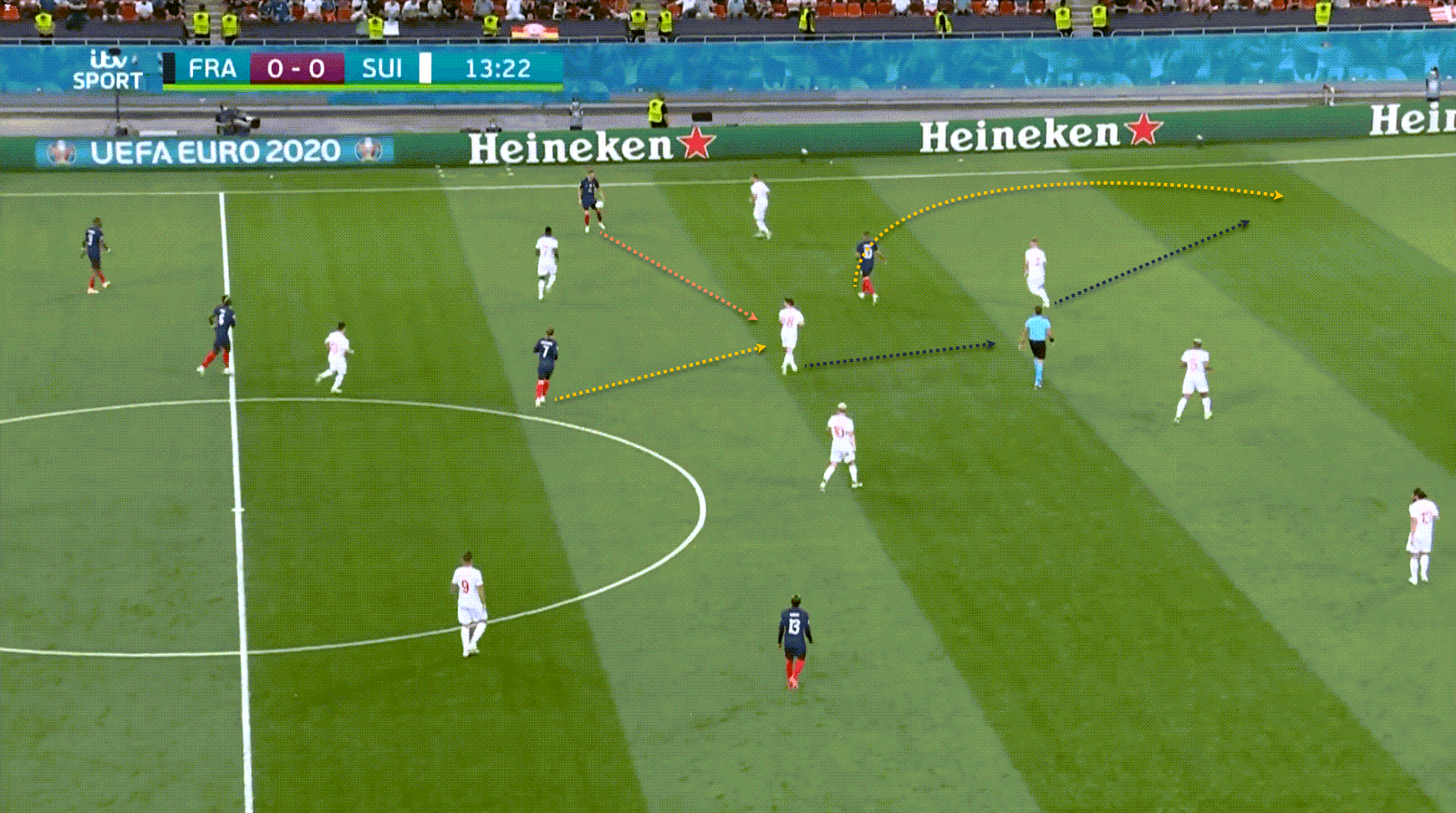
There was an odd lack of dynamism from France in the first half, and this can be seen here. When Rabiot receives possession, Mbappé, who has dropped short, can easily sprint in behind, forcing Nico Elvedi to follow him and opening space up in the Swiss backline. Freuler would then be forced to drop in and this would open up space centrally for Griezmann to receive possession and drive forward. However, Mbappé does not make this run, and Rabiot is then only able to pass the ball back to Pogba. Interestingly, Mbappé does make that run in behind when Pogba gets on the ball, but Elvedi is able to cover quite easily in that instance, having stayed goalside of the Frenchman. This summed up France’s issues in the first half – lack of penetration, zero dynamism and no wide threat.
Switzerland profit down their left
Switzerland, on the other hand, were intelligently able to shift between their 4-4-2 and 3-4-1-2 shapes, depending on the state of play. Their shape while defending was usually a 5-3-2…
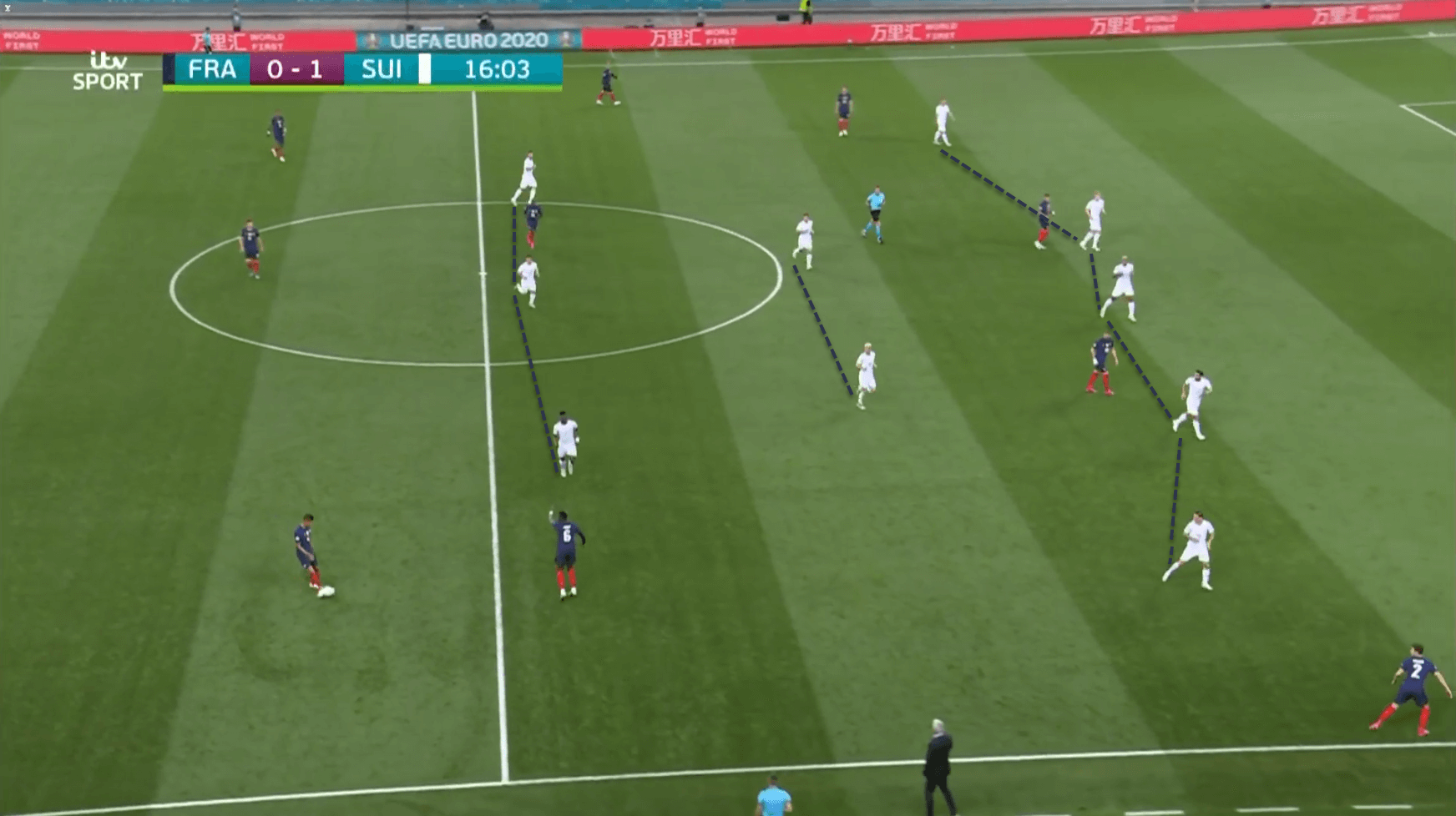
…while it morphed into a 4-4-2 when they got on the ball.
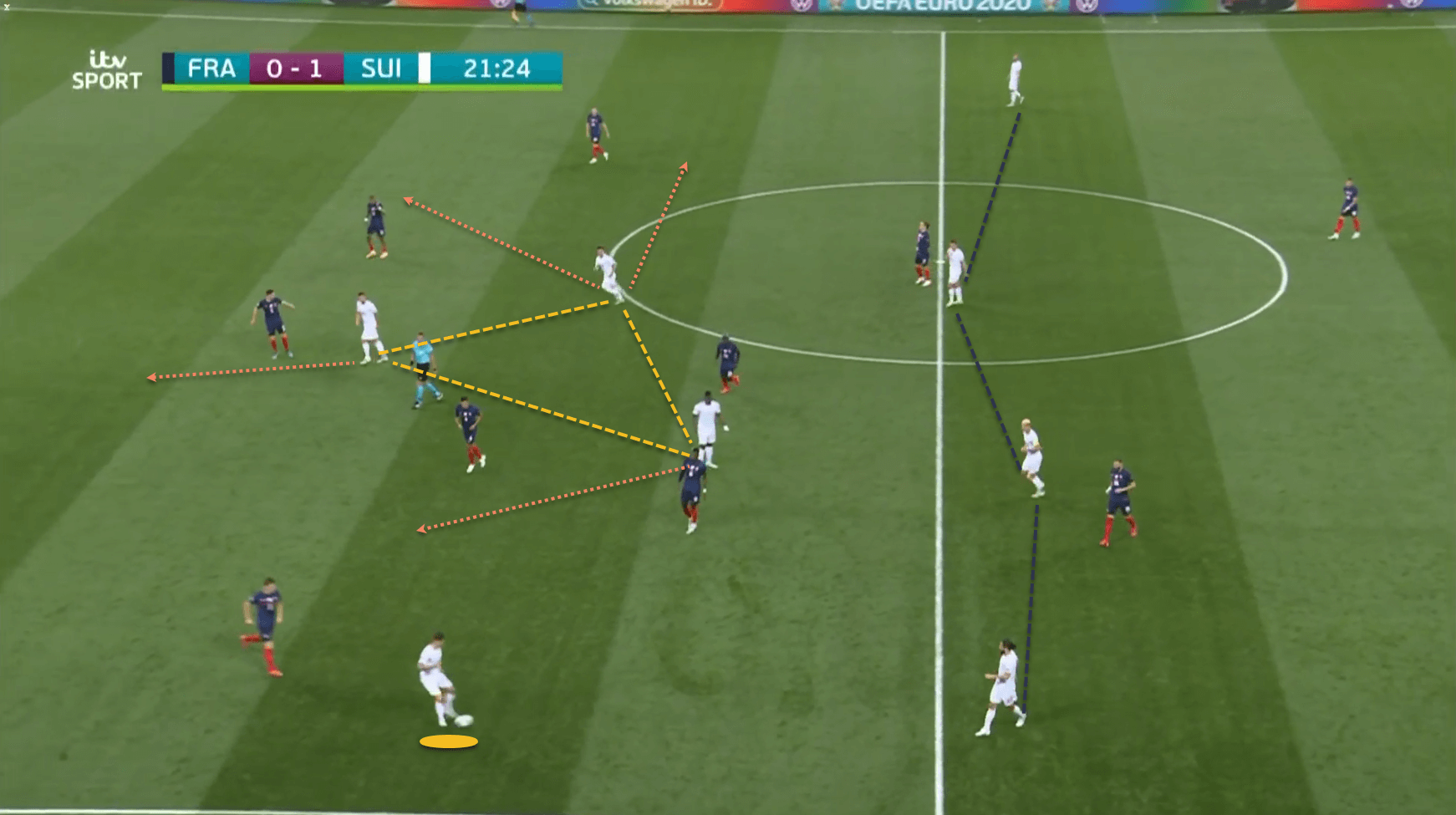
Ricardo Rodríguez would push out to left-back from centre-back, with Steven Zuber moving into an advanced position on the left. On the opposite side, Xherdan Shaqiri came infield from his nominal right wing position to play in the central areas, while Breel Embolo dropped off from the backline, and Seferović provided a physical presence upfront.
The majority of Switzerland’s attacks in the first half came down their left – France often shifted into a lopsided 4-4-2 while defending, with Rabiot pushing into midfield, while Pogba stayed tucked in centrally. This meant that Rodríguez and Zuber were often able to create 2v1 situations against Pavard on the left, and Switzerland’s opening goal also came from a cross from Zuber from the left that was headed in by Seferović.
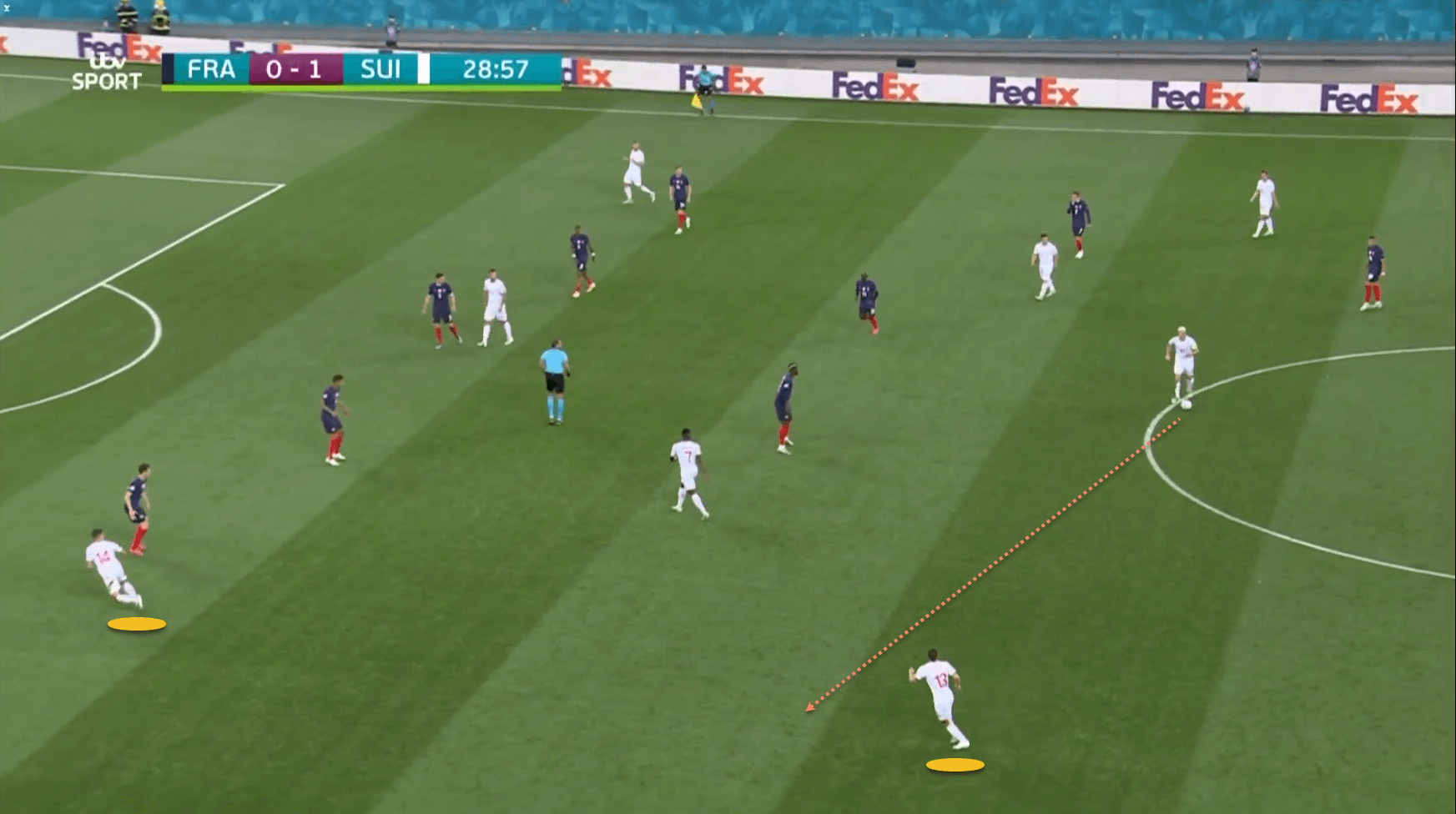
Notice how Rodríguez has acres of space to run into and receive the ball from Granit Xhaka here, with Zuber pinning Pavard ahead of him on the flank.
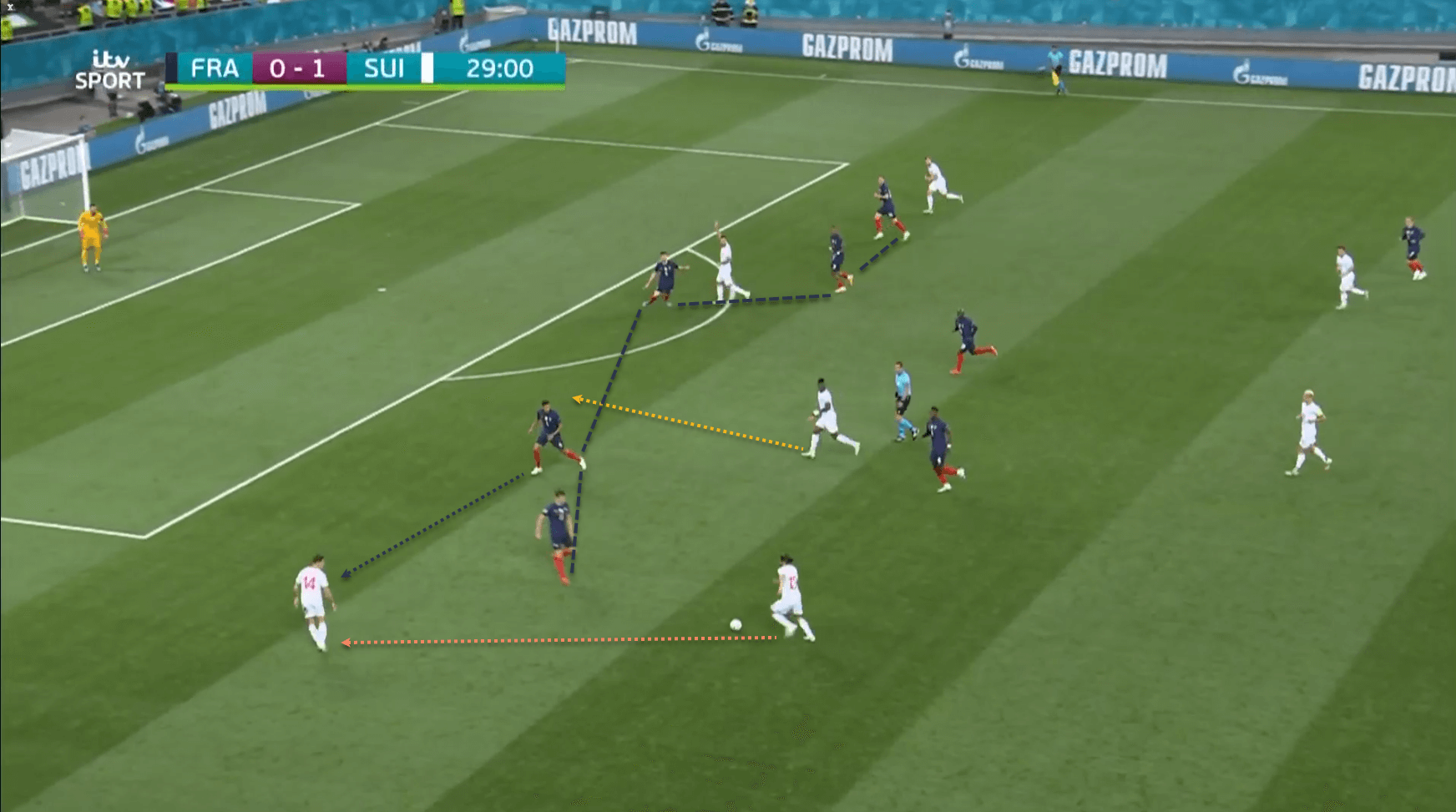
Rodríguez advances and forces Pavard to come out and engage, which means that Zuber is now in space, as Varane is scrambling across to cover. This, in turn, opens up a gap between him and Lenglet into which Embolo can advance – Rodríguez ends up passing to Zuber rather than Embolo, but this is a good example of how Switzerland were able to pull France’s defenders out of position.
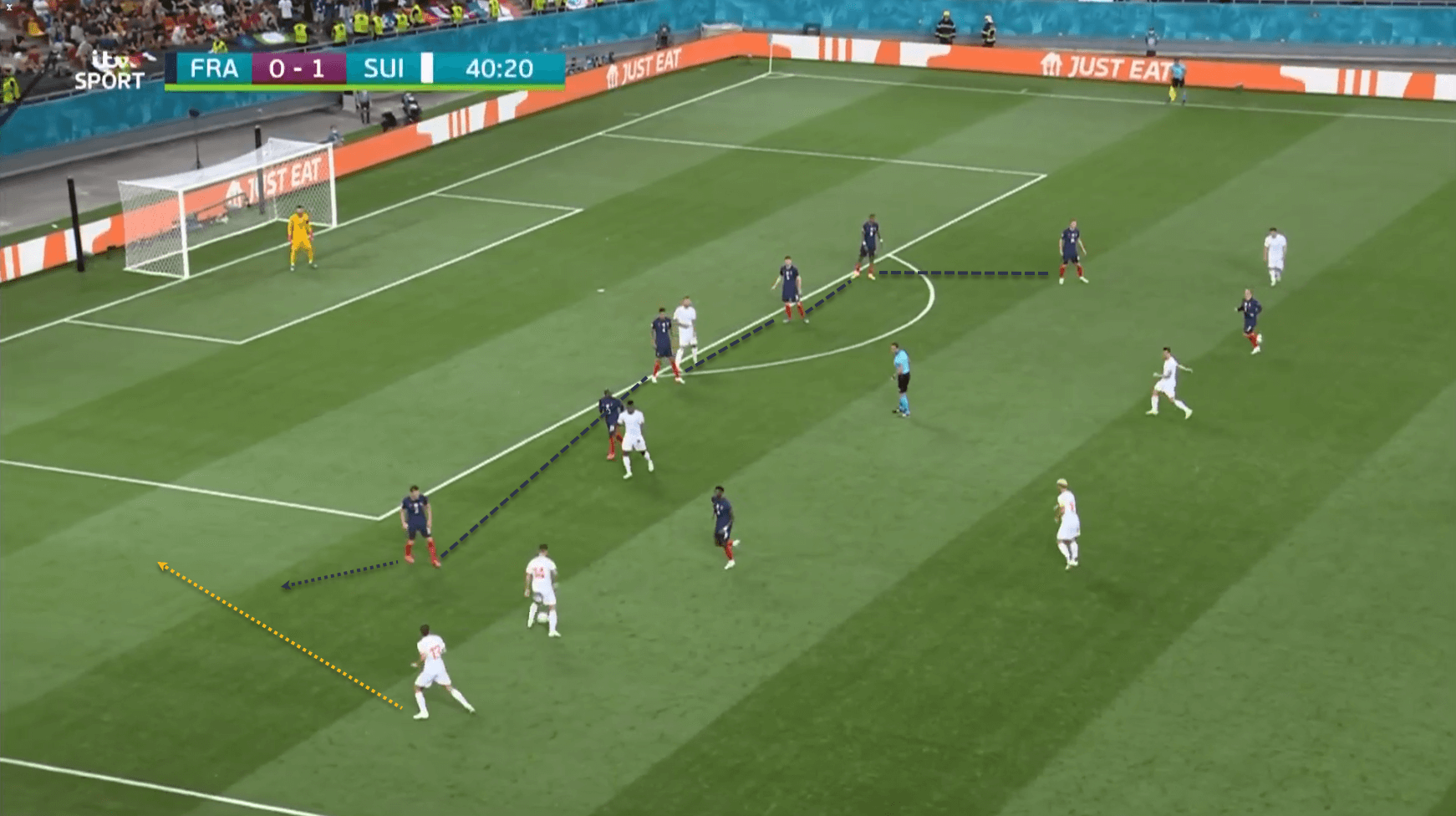
Another example of this here – this time, it is Rodríguez overlapping Zuber, with Pavard once again forced to move wider and track the overlapping player, opening up space centrally.
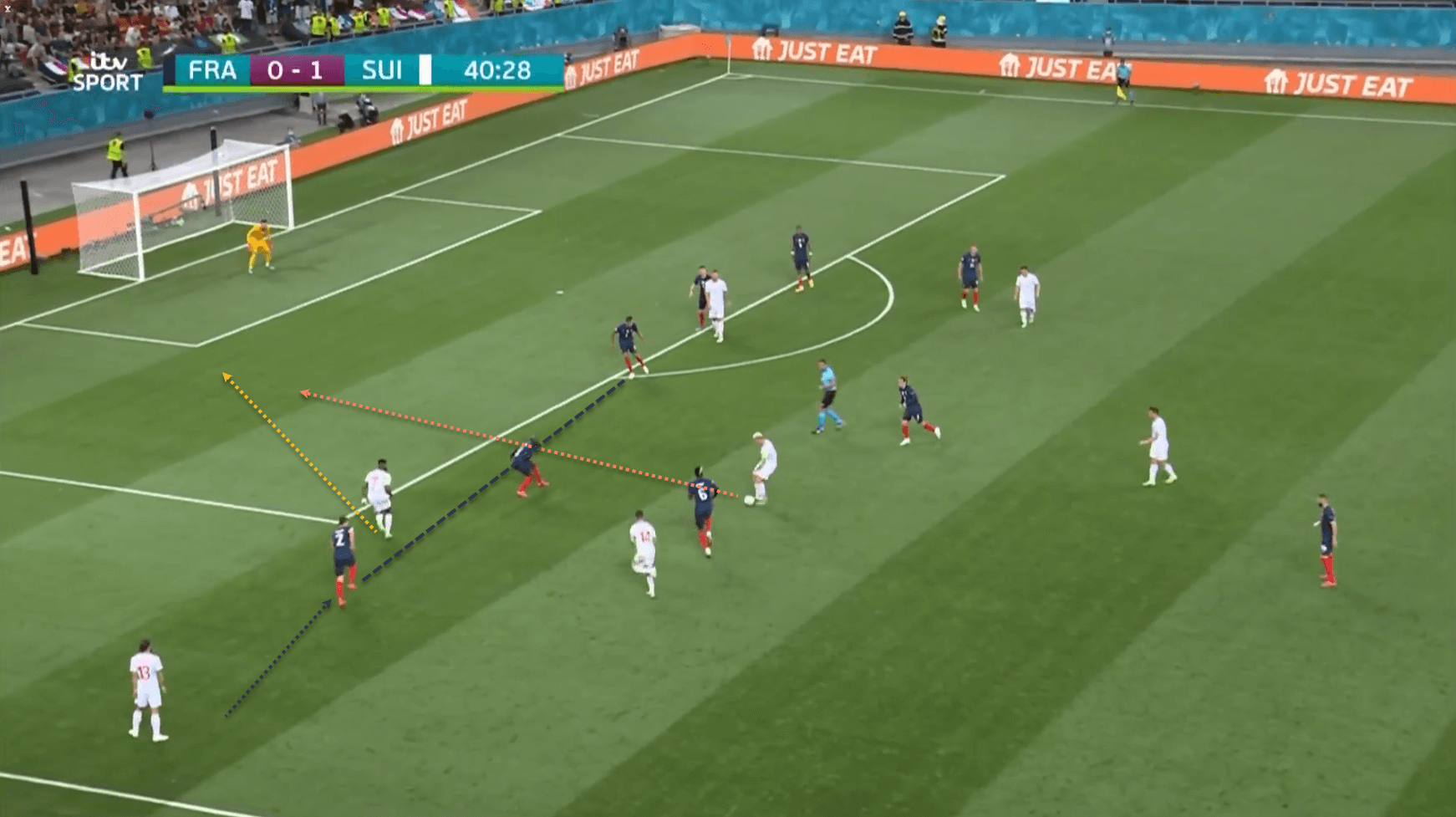
The ball was played out to Rodríguez and back to Zuber, who moved it on to Xhaka. By this time, Embolo has drifted behind Kanté, while Pavard, who was drawn towards Rodríguez, is too wide to cover as well. Xhaka is able to thread a pass into the space between the French centre-backs for Embolo to run onto, and only a poor first touch denies the Borussia Mönchengladbach forward a one-on-one opportunity with Hugo Lloris.
The second half, however, saw quite a few changes from both sides, which helped to change the flow and state of the game.
Second half changes
As mentioned earlier, Deschamps hooked Lenglet at half-time, bringing on Coman instead with France moving to a 4-4-2 with Rabiot at left-back and Coman ahead of him on the flank. Les Bleus were a greater threat almost immediately – Coman stayed wide and high on the left, which gave Widmer a direct opponent to deal with and forced him wider as well, opening up space in the channel between him and Elvedi for Benzema, Griezmann and Mbappé to try and exploit.
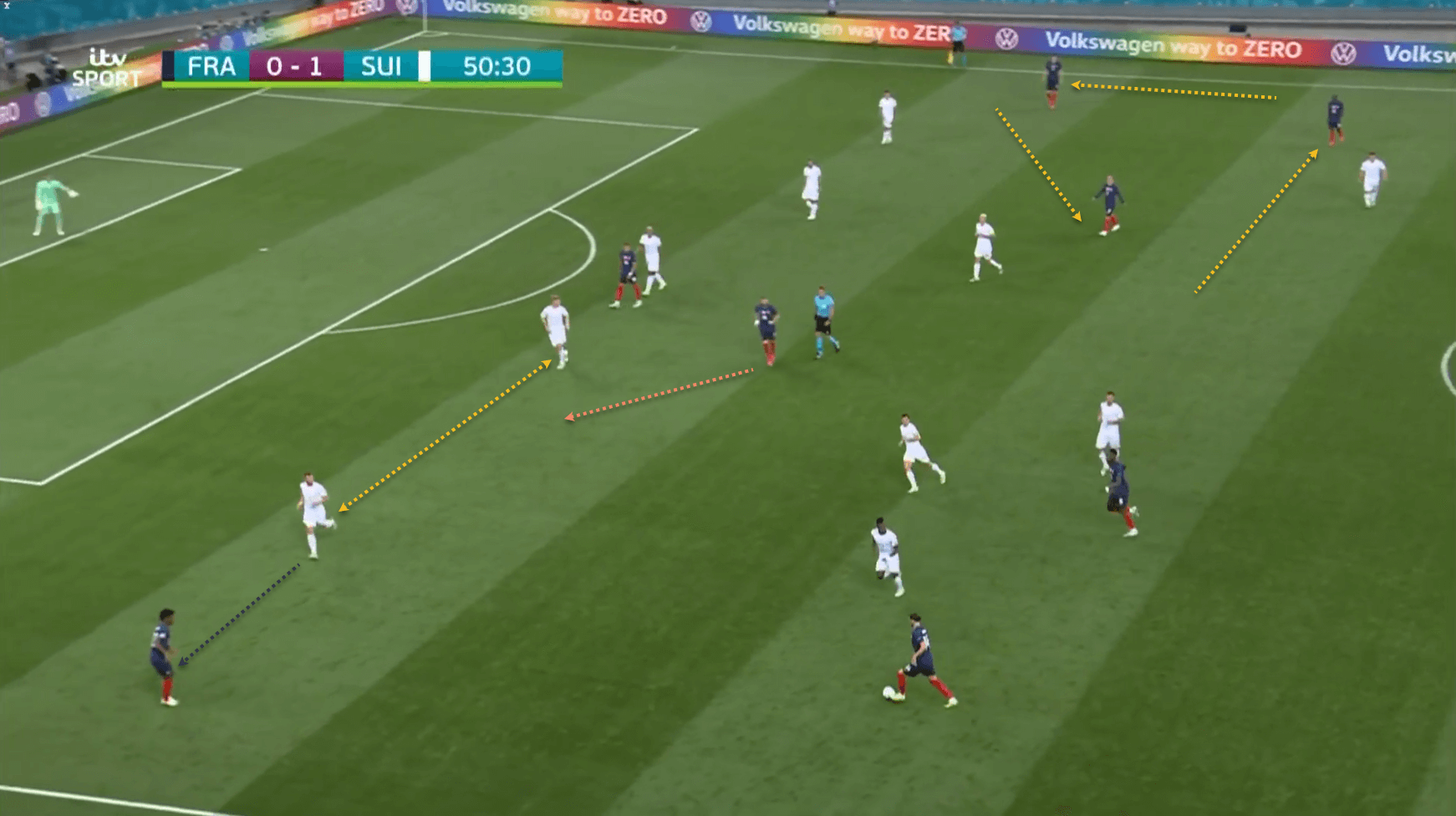
As Rabiot drives forward with the ball, Widmer has to stay deeper and wider to mark Coman, opening up space for Benzema to run into. Also note the rotation on the right flank for France, with Griezmann moving infield, Pavard staying high and Kanté dropping behind him to cover.
France were therefore a much greater threat in this half, and scored two quick goals after Rodríguez’s penalty was saved by Lloris to completely change the dynamic of the match. When Pogba scored their third with a sumptuous curling effort from 25 yards, it seemed as though Switzerland were down and out. However, a combination of poor French defending and direct Swiss attacking hauled them back into this match.
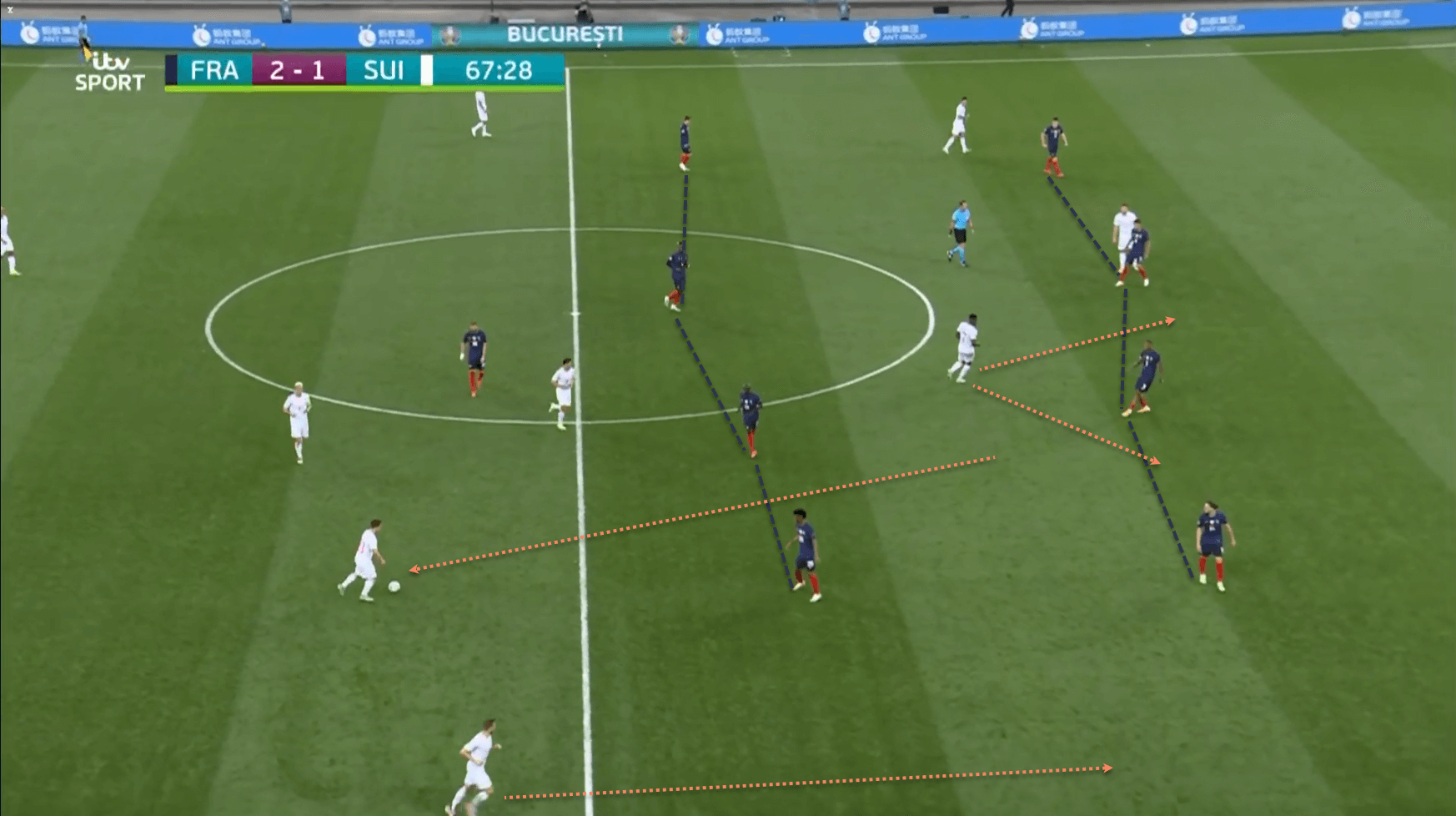
Shaqiri began to drop into midfield from his right-sided position, allowing Widmer to bomb forward on the overlap. This gave Switzerland a little more control, especially as France sat back to defend their lead. At the same time, Embolo would also drop off to receive between the lines and run at the French defence, with Seferović staying higher and forcing the defensive line deeper.
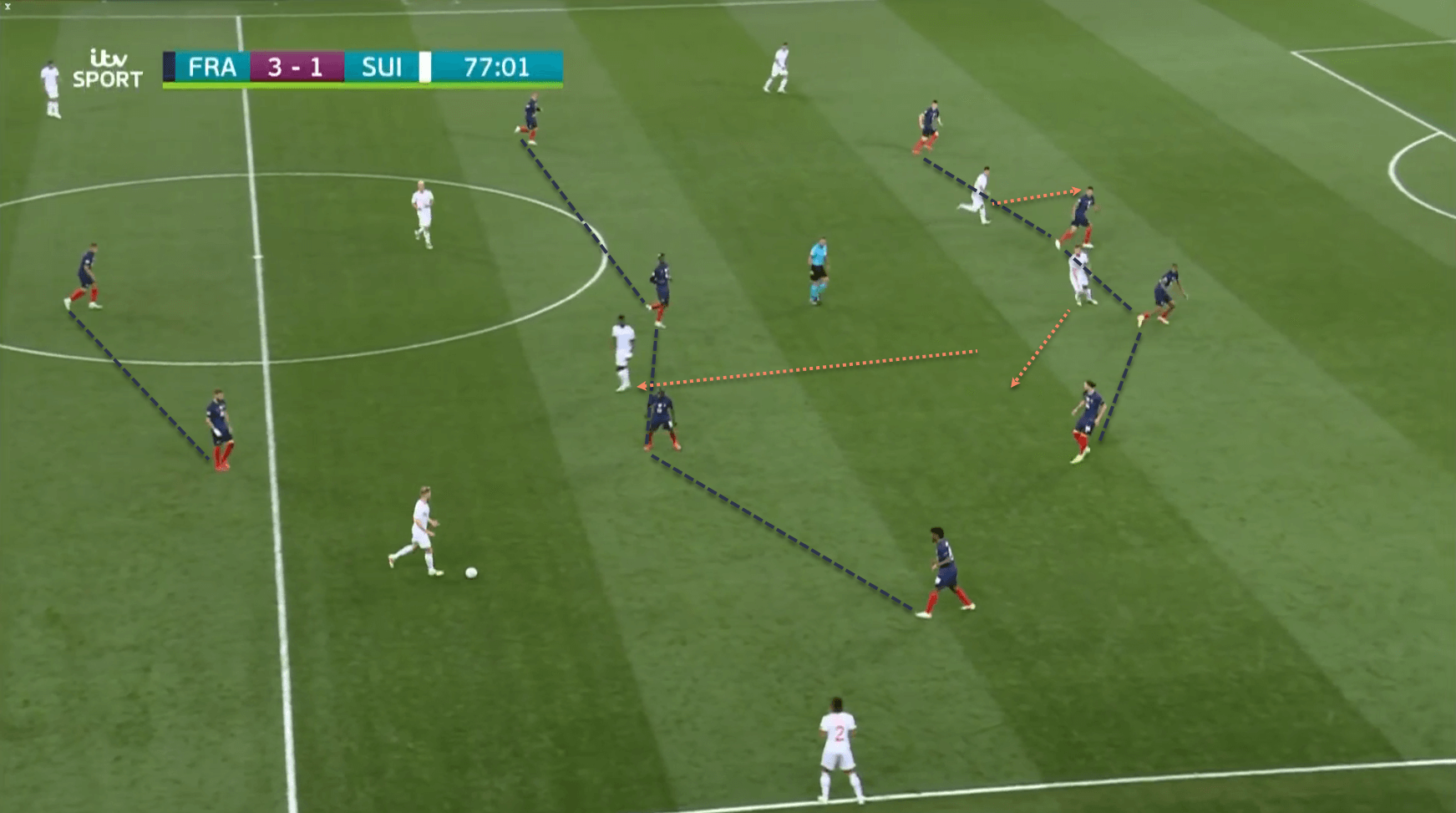
This theme continued even after Shaqiri was substituted. Embolo would drop even deeper now, with Seferović also dropping off to receive the ball to feet, as the substitute Gavranović would stretch the French backline through his pace in behind.
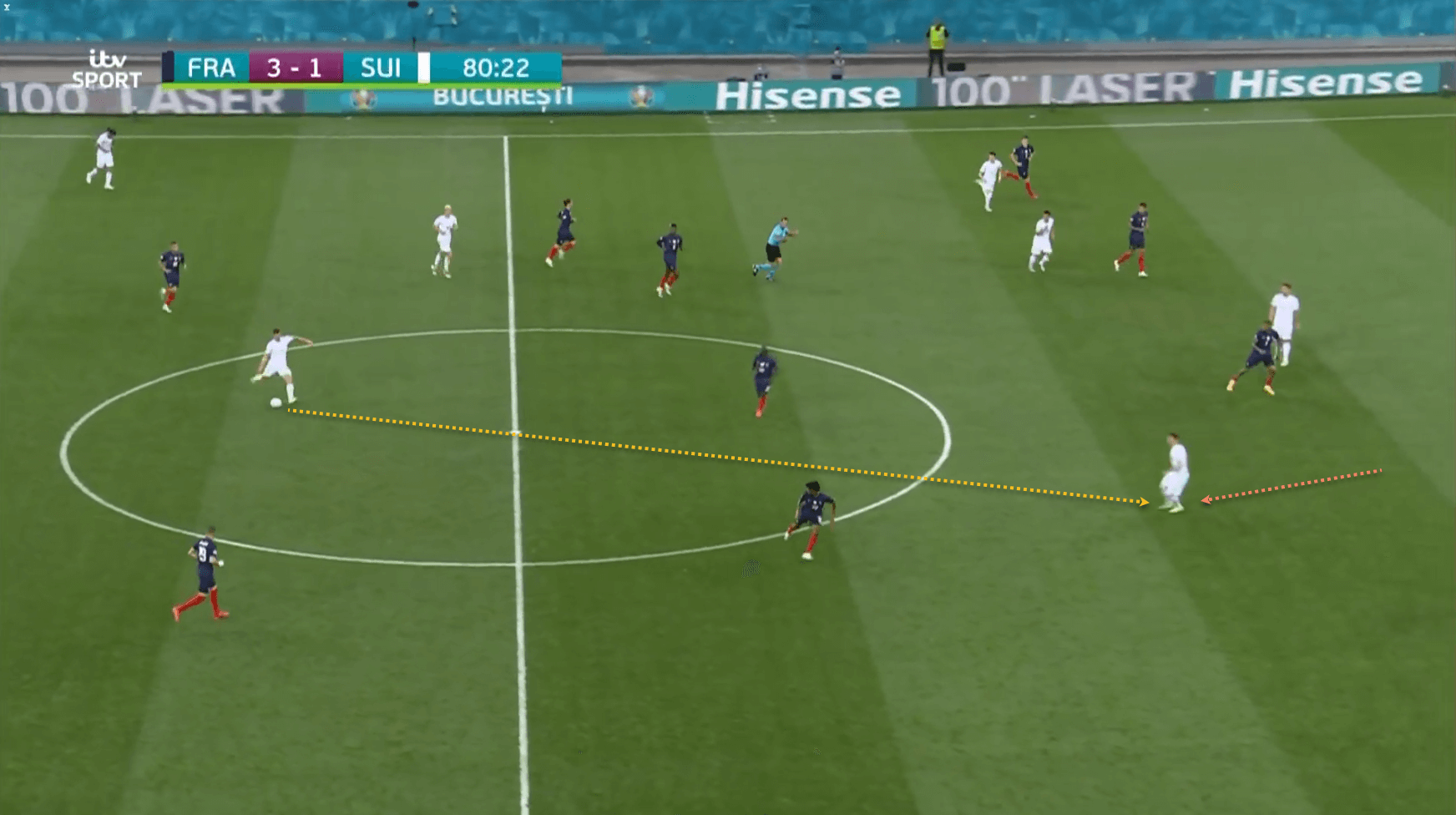
This is in the build-up to Switzerland’s second goal. Substitute Christian Fassnacht drops off from the backline, and Remo Freuler is able to find him between the lines with a good pass.
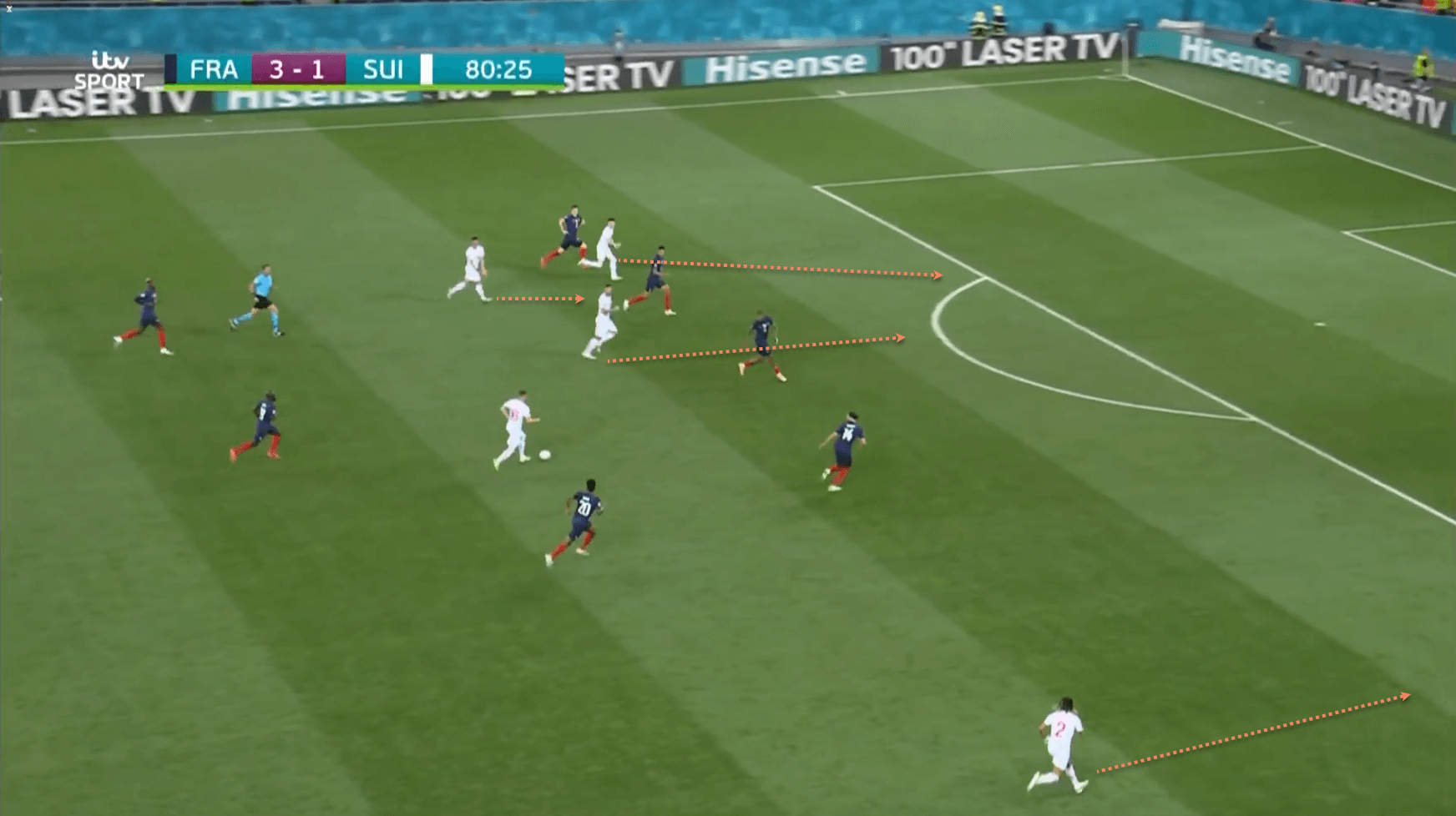
As he turns and runs, there are three Swiss players to his left making a run into the French penalty area, while Kevin Mbabu, another substitute, is storming up the flank to his right in a lot of space. Fassnacht initially elects to play the ball to the left, where it is intercepted, but he is able to recover and play the ball out to Mbabu…
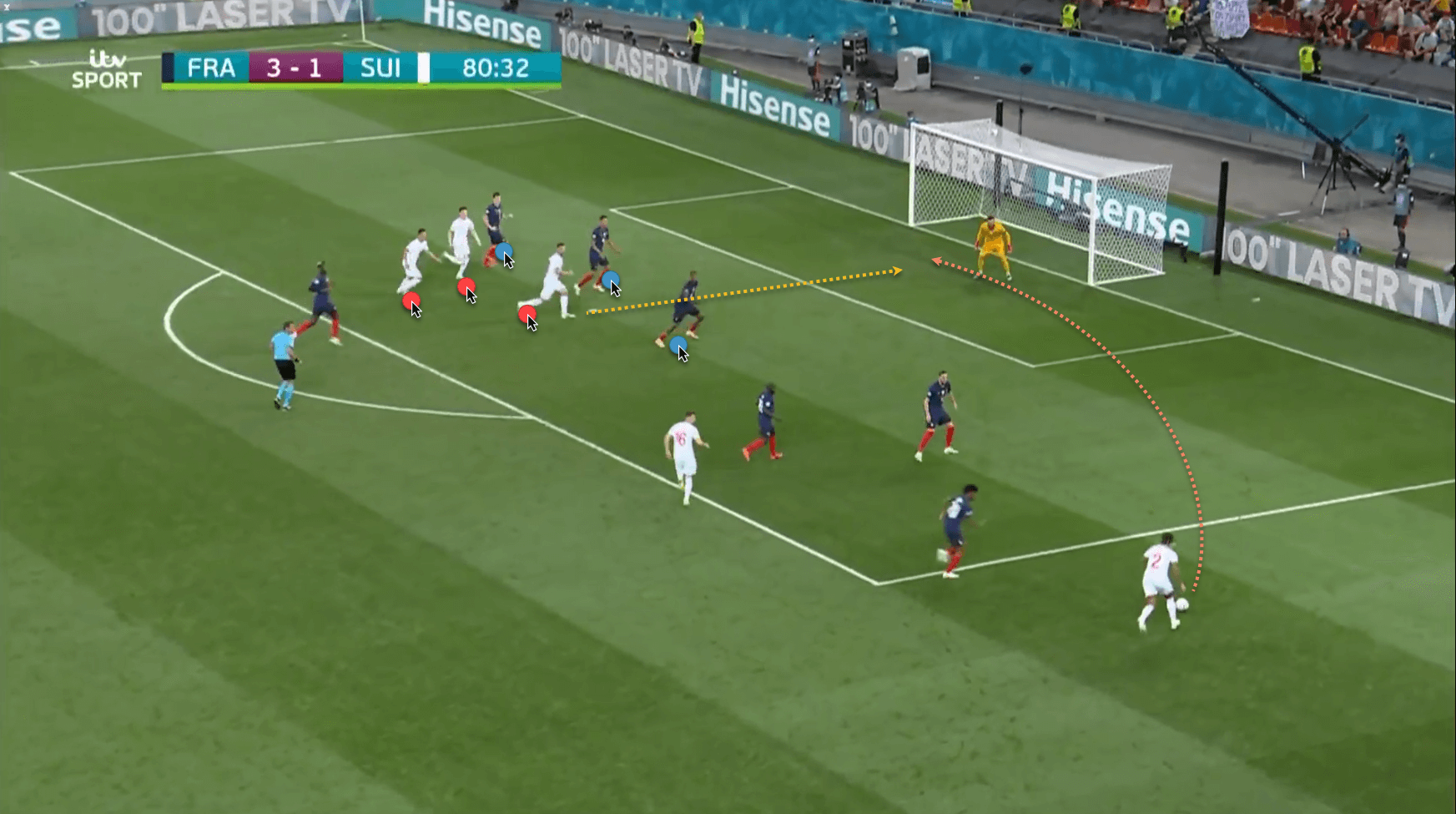
…who is able to play a brilliant ball into the box for Seferović to score. Note how Switzerland have three players in the box, all on the far side, which causes confusion among the French defenders and is a possible reason why Seferović is able to dart between Varane and Kimpembe to head the ball in.
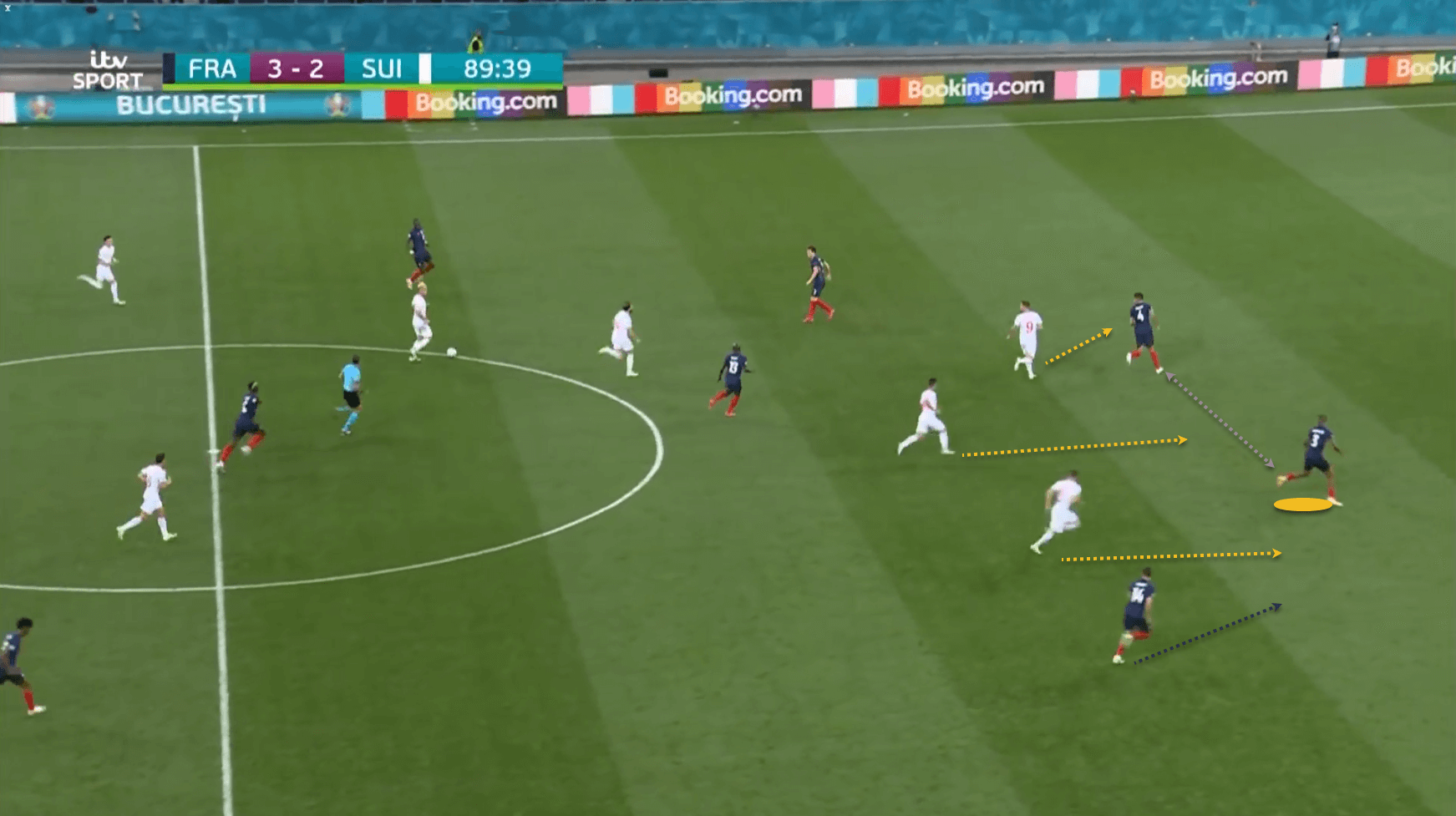
It was a defensive lapse that led to the equaliser. As Switzerland poured forward in the last minute, note how Seferović, Gavranović and Fassnacht are all making forward runs. Fassnacht’s run, in particular, drags Kimpembe to the left, opening up space between him and Varane, even though Rabiot is covering the Swiss subsitute.
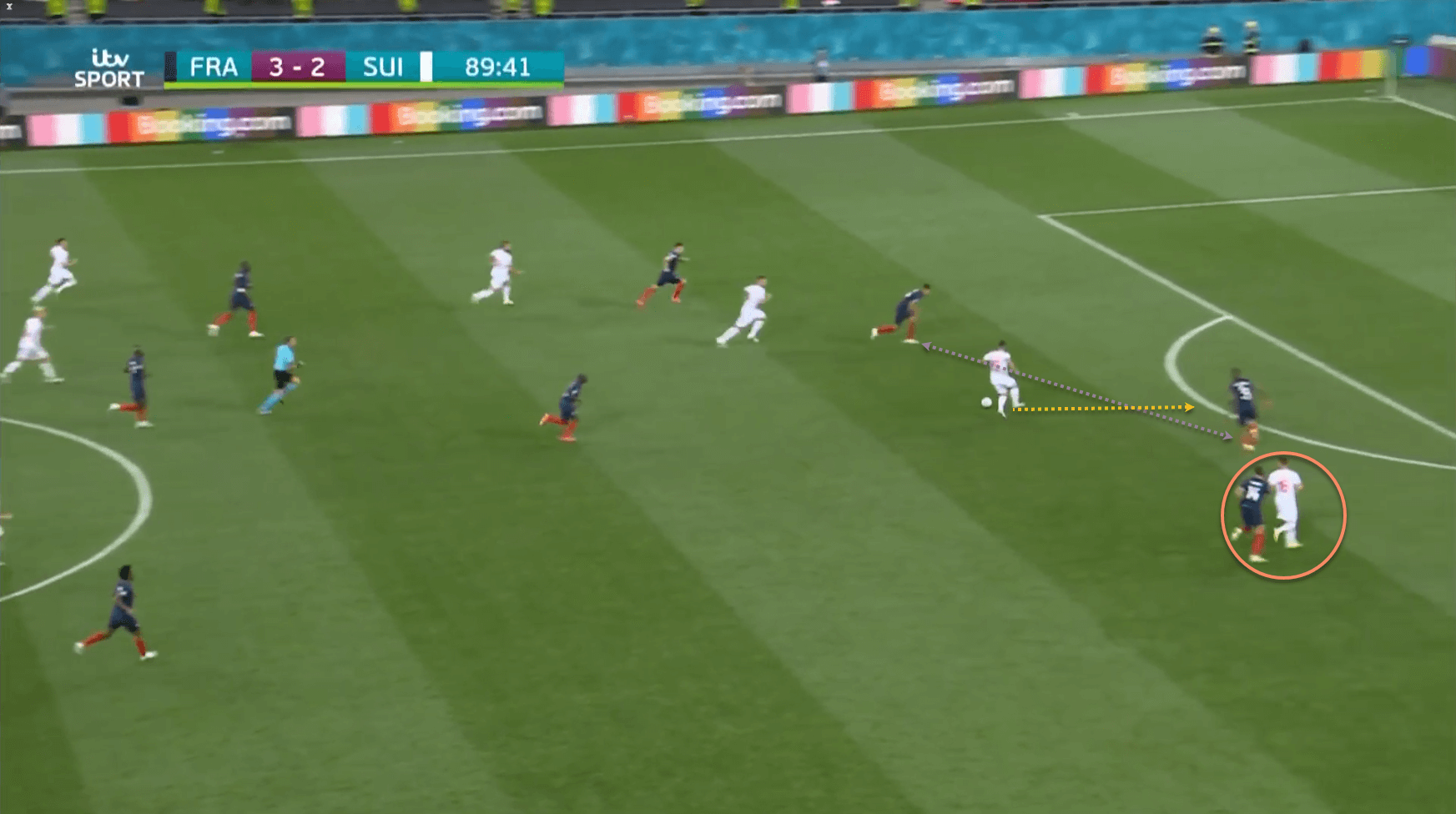
Xhaka plays a fantastic pass for Gavranović, who now has even more room to run into between the two French centre-backs. Rabiot has managed to catch up to Fassnacht, showing how Kimpembe needed to be more aware of his surroundings – he definitely did not need to be dragged wide there, and as a result, is scrambling to recover when Gavranović receives the ball. The Dinamo Zagreb forward is able to sidestep him and hammer a finish into the net, thus forcing extra-time and capping a stupendous Swiss comeback.
Conclusion
There is the temptation to conclude that France were unlucky in this match, since they only lost on penalties, and came quite close to scoring the goals that would have seen them win the match in normal time, or even extra-time. However, doing so ignores the fact that France were not at their best here – especially in the first half, when they seemed inhibited by an unfamiliar system. That is purely on Deschamps, and while he did rectify things at half-time, it was not enough, and France have now crashed out of EURO 2020, a tournament they were widely expected to win. Switzerland played out of their skins in this game, and will go into the match against Spain with sky-high confidence, although they will be without Xhaka, who was booked and therefore will be suspended.





Comments